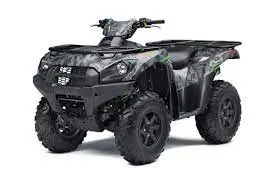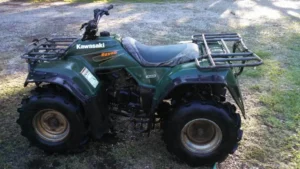Kawasaki Bayou 300 Because of its tough build, 4×4 capabilities, and dependable performance, is a popular all-terrain vehicle (ATV).
Popular ATVs like the Kawasaki Bayou 300 are renowned for their dependability and efficiency. But just like any car, it could have typical issues. Owners of Kawasaki Bayou 300s have reported the following problems.[Kawasaki Bayou 300]
Read About: 5 Common Kawasaki Brute Force 300 Problems And Solutions [2024]
Kawasaki Bayou 300 Problems
Starting Issues: A typical issue is having trouble getting the ATV to start. There may be problems with the ignition system, starter motor, or battery. To identify and fix starting issues, check the battery charge, make sure all electrical connections are made correctly, and look over the starter motor.
Electrical System Problems: Owners of Bayou 300s have reported experiencing electrical problems, including issues with wiring, lights, and the ignition switch. These problems may be resolved by making sure all electrical connections are tight, checking the wiring for damage, and swapping out any malfunctioning parts.
Overheating: Overheating, often caused by harsh weather or extended use, can damage the engine if not addressed promptly. Preventing this can be achieved by cleaning the radiator and checking coolant levels.
Brake Problems: Brake-related problems, such as brake fade, decreased stopping power, and loud brakes, can be managed by regularly inspecting brake pads, discs, fluid levels, and adjusting the brake system.
Oil Leaks: The Bayou 300, a popular luxury car, has been experiencing oil leaks, requiring immediate attention to prevent potential engine damage and oil loss.
How Much is a Kawasaki 300 Bayou Worth?
ATVs vary greatly in value depending on a number of criteria, such as the model year, customizations, state of the ATV, and demand in the local market. As of the deadline in January 2023, I am not aware of any current pricing information. I can, however, offer some broad advice on elements that may affect a Kawasaki Bayou 300’s worth.
For a 300 Bayou that is in good running shape and has no significant mechanical problems or between $1,500 and $2,000 in total. Naturally, costs might differ based on where you buy your ATV .

What Is the Top Speed of a Kawasaki Bayou 300?
The Kawasaki Bayou 300‘s maximum speed can vary depending on factors like the rider’s weight, terrain, and surrounding conditions.
With a peak speed of about 48 mph, it provides more than enough power for a starting rider. That should be more than enough for the trails this bike can tackle. Throttle control is rather enjoyable in and of itself, and it can be easily mastered by both novice and expert skill sets.
Where is the Rectifier on a Kawasaki Bayou 300?
On a Kawasaki Bayou 300, the rectifier is usually found close to the ATV’s electrical system. The rectifier is a crucial part that powers the ATV’s electrical components and charges the battery by converting alternating current (AC) produced by the stator into direct current (DC).
To locate the rectifier on a Kawasaki Bayou 300, follow these general steps:
Refer to the Owner’s Manual: Trustworthy sources of information for ATV owners include handbooks with diagrams and locations of components, such as rectifier, making them the primary source of information.
Inspect the Electrical Components: The rectifier, a crucial component of an ATV’s electrical system, should be closely examined around the battery and the ATV’s frame or chassis.
Look for a Rectangular Box: The rectifier, typically rectangular or box-shaped, may have fins or cooling elements for heat dissipation and can be mounted on the ATV’s frame or another accessible location.
Check Near the Front or Rear of the ATV: Rectifiers are typically placed near the front or rear of an ATV for accessibility and cooling, especially around the battery compartment.
How Do You Adjust the Clutch on a Kawasaki Bayou 300 4X4?
Adjust the clutch cable of a Kawasaki Bayou 300 4×4 to ensure correct clutch engagement and disengagement, as outlined in a general guide.
Locate the Clutch Cable: Determine the Kawasaki Bayou 300’s clutch cable. The motion from the clutch lever to the clutch mechanism is transferred by the clutch cable.
Loosen the Lock Nut: Loosen the lock nut on the clutch cable adjustment mechanism with a wrench to adjust the cable’s length.
Check Free Play: After making changes, check the clutch lever’s free play, which should be slightly loose before engaging the clutch, ensuring it is fully disengaged upon release.
Test the Clutch Lever: Test the clutch lever after making the necessary modifications to make sure the clutch engages and disengages smoothly. The clutch should engage easily and without too much play or resistance, and the lever should feel responsive.
Refer to the Owner’s Manual: Please consult your Kawasaki Bayou 300 owner’s handbook for detailed instructions, specs, and suggested clutch adjustment techniques. The handbook offers useful details specific to your ATV model.

Conclusion:
The Kawasaki Bayou 300, a legendary all-terrain vehicle, is renowned for its toughness, functionality, and off-road capabilities, making it a reliable companion for enthusiasts seeking challenging experiences.
The Bayou 300, a reliable 4×4 ATV, offers an exciting and thrilling ride on hard terrain, making it a popular choice for both recreational and utilitarian users.
The Kawasaki Bayou 300, a timeless classic in the ATV community, is renowned for its simple design, reliable components, and versatility.
The Kawasaki Bayou 300, a symbol of discovery and mastery of nature’s challenges, serves as a lasting reminder of Kawasaki’s commitment to creating enduring off-road classics.

